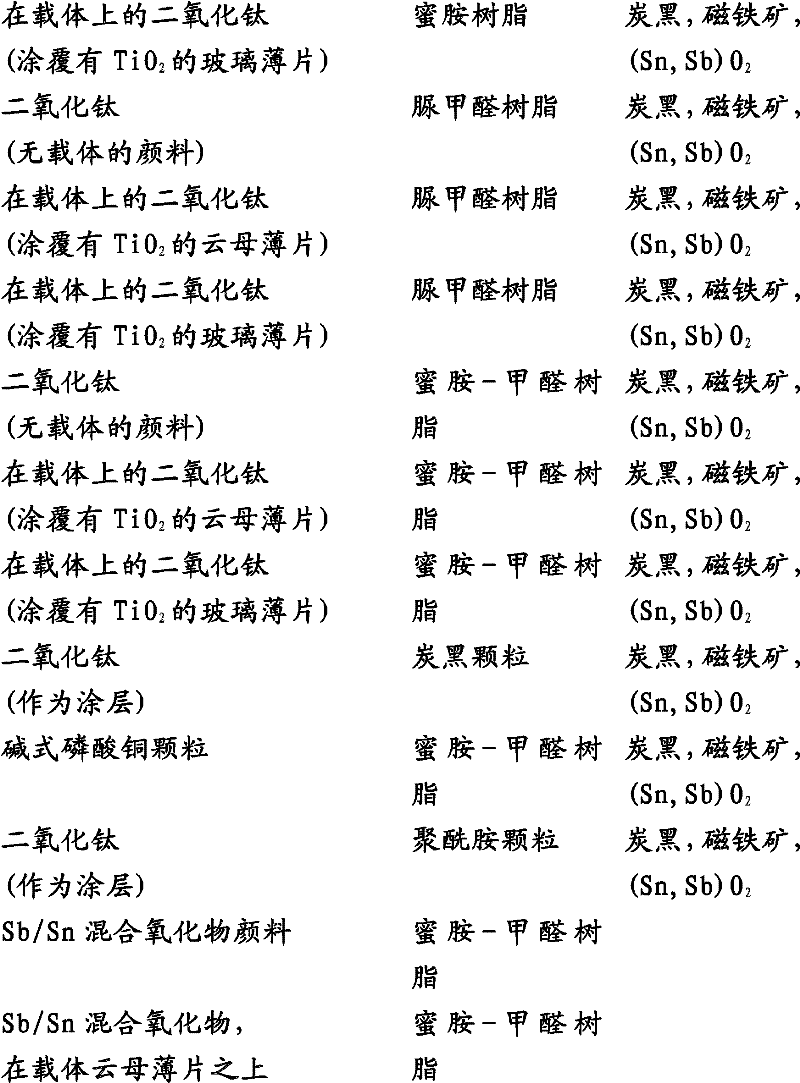Pigment for laser marking
A laser marking and pigment technology, applied in powder paints, paper coatings and papermaking materials, organic polymers, plastics, automotive paints, printing inks, and painting fields, which can solve problems such as failure to introduce industrial applications.
- Summary
- Abstract
- Description
- Claims
- Application Information
AI Technical Summary
Problems solved by technology
Method used
Image
Examples
Embodiment 1
[0101] 100 g of rutile-titanium dioxide pigment (RN 2900 from Kronos) with a particle size range of 100-500 nm was slurried in 150 g of water. 25g of melamine resin (Madurit powder of Ineos company) and 0.1g of carbon black content of 25% carbon black aqueous dispersion (Derussol N25 / L of Evonik company) are stirred in this titanium dioxide suspension, and whole batch of material is in Dispersion in a ball mill (ball mill attachment for "Dispermat" dissolvers from the company Getzmann). The fully dispersed batch was then heated to 70° C. and adjusted to pH=4 with about 30 ml of a 25% p-toluenesulfonic acid solution. After a reaction time of 30 minutes, the batch was allowed to cool and then filtered through a suction filter. Drying was carried out overnight at 180°C.
[0102] The material thus obtained has D 95 =20 μm particle size (measured under standard conditions with a Mastersizer 2000 from Malvern Instruments Ltd.) and incorporated at 1% into polypropylene by means of ...
Embodiment 2
[0109] 80 g of an aqueous urea-formaldehyde resin solution with a resin content of 50% (Kaurit 210 liquid from the company BASF) were diluted with 100 g of water. 0.02 g of flame black FW1 from the company Evonik were stirred into the solution. 100 g of anatase-titanium dioxide pigment (Kronos 1171) with a particle size of 100 nm to 500 nm were stirred in the dissolver and then stirred at an increased number of revolutions (2500 rpm = about 8 m / s for a dissolver disc diameter of 60 mm) Peripheral speed) dispersion. The fully dispersed batch was then heated to 70° C. and adjusted to pH=4 using about 4 ml of 25% citric acid solution. After a reaction time of 30 minutes, the batch was allowed to cool and then filtered through a suction filter. Drying was carried out overnight at 180°C.
[0110] The material thus obtained has D 95 =30 μm particle size (determined analogously to Example 1) and stirred into a 10% aqueous solution of polyvinyl alcohol. Using a doctor blade, a fil...
Embodiment 3
[0112] 20g silver nitrate (AgNO 3 ) was dissolved in 100g of water. 50g particle size D 95 =30 μm kaolin was stirred into the solution and silver was loaded onto the kaolin as silver chloride (AgCl) by adding dropwise 80 g of a 10% NaCl solution with stirring. The suspension was adjusted to pH 8 with NaOH before adding 30 g of Madurit MW116 (75% melamine-formaldehyde resin solution from Ineos). The batch was then heated to 70°C and upon reaching this temperature acidified to pH 3-4 by slow dropwise addition of 1 M HCl. After a reaction time of about 30 minutes, the whole mixture was cooled and filtered through a suction filter. Drying was carried out overnight at 180°C.
[0113] The material thus obtained has D 95 =100 μm particle size (determined analogously to Example 1) and incorporated into polypropylene at 0.5% by means of an extruder. The compound was then molded on an injection molding machine to obtain test pieces with dimensions 9.0 cm x 6.0 cm x 0.15 cm. Simil...
PUM
| Property | Measurement | Unit |
|---|---|---|
| particle diameter | aaaaa | aaaaa |
| particle diameter | aaaaa | aaaaa |
| particle diameter | aaaaa | aaaaa |
Abstract
Description
Claims
Application Information
 Login to View More
Login to View More - R&D
- Intellectual Property
- Life Sciences
- Materials
- Tech Scout
- Unparalleled Data Quality
- Higher Quality Content
- 60% Fewer Hallucinations
Browse by: Latest US Patents, China's latest patents, Technical Efficacy Thesaurus, Application Domain, Technology Topic, Popular Technical Reports.
© 2025 PatSnap. All rights reserved.Legal|Privacy policy|Modern Slavery Act Transparency Statement|Sitemap|About US| Contact US: help@patsnap.com


